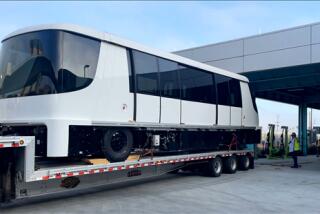Rebirth of Angels Flight
- Share via
When Angels Flight, the L.A. landmark dubbed “the shortest railway in the world,” closed in 2001 after a fatal crash, many wondered whether it was gone for good.
Officials announced Tuesday that the funicular will reopen this summer -- but Angels Flight will return to a decidedly different downtown Los Angeles.
In the six years during which Angels Flight has been out of operation, downtown has seen a remarkable residential transformation. Luxury lofts and high-rise condos have sprung up nearby, adding thousands of people to downtown’s residential population and changing downtown’s profile from a sleepy city center into a much more vibrant, hip neighborhood.
With the massive Grand Avenue project about to break ground atop Bunker Hill, there is a growing feeling that the new Angels Flight will actually serve as a valued form of transportation downtown -- not just as a tourist attraction.
It’s a strange turn of events for the fabled railway, which has served as both an icon for L.A.’s sense of daring and its long neglect of its city core.
In many ways, the two rail cars that climb up Bunker Hill -- known as Olivet and Sinai -- would barely recognize their old haunts.
Cultural institutions, including the Walt Disney Concert Hall and the Cathedral of Our Lady of the Angels, have opened their doors, and the Colburn School is in the midst of a major expansion. A Ralphs market will open in June -- the area’s first supermarket in half a century. And other amenities, including new restaurants and bars, are mixed in throughout the corridor.
At a news conference Tuesday, officials showed off the refurbished railroad and announced that they were about to begin the third phase of the railway’s $2.6-million restoration, which will include installation of a new drive system and safety improvements. They also expressed excitement that as new developments, including the nearby Grand Avenue project, reach completion, Angels Flight might actually be used again for commuting.
“Angels Flight was an interesting part of downtown,” said John Welborne, president of Angels Flight Railway Foundation, which took over the railroad after the 2001 accident and has raised funds for its restoration. “Even more so now.”
The development boom has an ironic twist for Angels Flight.
The rail line was designed to connect downtown with the once-bustling residential community on Bunker Hill. But when the city leveled that neighborhood as part of a 1960s redevelopment push, Angels Flight was left moribund.
The funicular closed at the end of that decade. It was revived in 1996 after years of efforts by preservationists.
The railway -- then as now -- plays an important role: connecting the historic downtown core along Broadway, Spring and Hill streets with the newer office towers, condos and cultural centers on Bunker Hill.
Marie Condron, a seven-year downtown resident who founded a popular neighborhood Internet bulletin board, said many residents who live in the historic core would frequent Bunker Hill if there were an easier way to get there. Right now, it involves hiking up several streets that are not exactly pedestrian-friendly.
“Most downtown residents are rooting for any of the bells and whistles that would make it more of a functioning neighborhood,” she said.
In many ways, the downtown that Angels Flight will return to is more similar to the one it was originally built to serve in 1901, when Col. J.W. Eddy built the funicular as a way to spare Angelenos the walk up Bunker Hill -- for the price of one cent a ride. At the time, Victorian mansions lined the double-barreled railroad’s tracks, and an observation tower at the top offered residents a view all the way to Boyle Heights.
These days, the area is ringed by different sorts of residences. The recently opened Metro 417 building, once the Subway Terminal building, offers upscale lofts starting at $1,400 a month. The Douglas and Pan-American buildings, a few blocks away, offer condo-style loft units. Farther east, the Historic District includes a handful of old bank buildings that have been revamped as housing. The projects join the Angelus Plaza Senior Citizens Housing Complex, opened in the 1980s, as well as several residential towers on Bunker Hill.
George Takei, a member of the Angels Flight Railway Foundation board who is perhaps best known as “Star Trek’s” Sulu, was at the news conference Tuesday. He remembered riding the funicular as a young child, when he visited downtown with his mother, and said he was glad to see downtown’s renaissance linked to the funicular’s resurrection.
“What is going on is that people get downtown,” Takei said. “They want the 24-hour lifestyle.”
A key piece of that lifestyle, he said, is transportation. “For the city to work, we need transportation to tie it together.”
As he spoke, volunteers from the Painters and Allied Trade Unions were putting the final touches on the Hill Street arch at the bottom of Bunker Hill. Officials did a spectrographic analysis to arrive at the black-and-orange color scheme that the funicular sported in the 1960s. In the previous restoration, the arch and the upper building were painted red and black.
Although Angels Flight has gotten a new paint job, much remains to be completed before its late summer opening.
Welborne said that before then, workers must replace the old drive machinery and install a number of new safety measures, including track brakes. Officials also are looking at additional safety measures, including a second cable or cable brake, designed to prevent the kind of accident that occurred in 2001. In that accident, a car broke loose and sped backward for almost a block before smashing into another rail car at the bottom of the hill, killing an 83-year-old man and injuring seven others. Federal investigators concluded that faulty mechanical and brake systems, combined with weak oversight, were to blame for the crash.
The entire system must be certified by the state Public Utilities Commission before it can be reopened, Welborne said.


